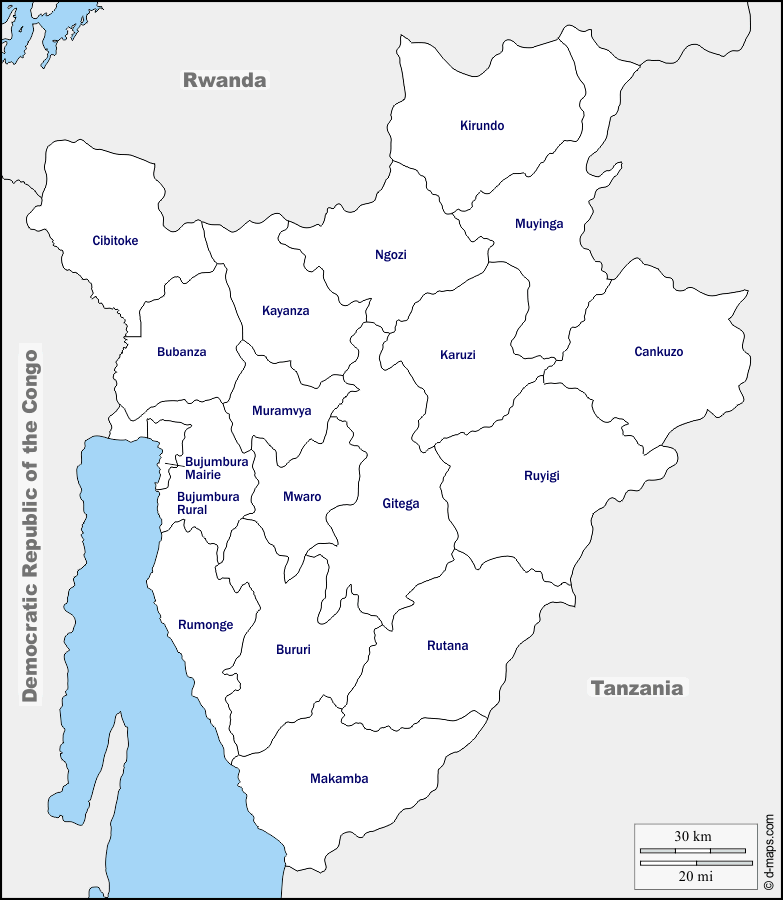Abstract
Ahead of the 2020 elections in Burundi, this contribution reviews the tumultuous trajectory of power-sharing in the country. From the signing of the Arusha Accord in 2000, power-sharing remained the object of persistent contestation between political rivals, leading to continuous transformations in both the institutions and the practice of power-sharing in the country. This paper traces these power-struggles and institutional evolutions throughout three periods during which Burundian power-sharing was negotiated (1998-2005), contested (2005-2015), and reshaped (2015-2020). The conclusion highlights some implications of this year’s elections for the future of power-sharing in Burundi.
Introduction
Burundi’s fourth cycle of post-conflict elections will be held between 20th May and 24th August 2020. Following a profound electoral crisis in 2015 and the adoption of a new Constitution in 2018, these elections stand out as the latest development in a series of power reconfigurations that have marked the dynamic of power-sharing in Burundi.
After more than ten years of civil war, decades of ethnic domination by the Tutsi minority (14%) over the Hutu majority (85%), and recurring waves of inter-ethnic violence, power-sharing aimed to deliver ‘security for the minority and democracy for the majority’ (Nindorera, 2019: 21). The complex institutional set up adopted in the 2000 Arusha Peace and Reconciliation Agreement and enshrined in the 2005 post-conflict Constitution combined provisions for power-sharing between both political parties and ethnic groups.

Power-sharing between political parties was provided by a National Assembly elected with a proportional representation (PR) electoral system; a coalition government where ministerial portfolios were distributed proportionally between the parties obtaining more than 5% of the votes; two vice-presidents from different political parties; and qualified majorities (2/3 for the adoption of ordinary laws and 4/5 for constitutional amendments).
Ethnic power-sharing was provided for by ethnic quotas in the National Assembly and in the Government (60% Hutu/40% Tutsi), in the Senate and the Armed Forces (50%/50%), and in the local administration (67%/33%); as well as ethnic distribution requirements on closed party lists for legislative elections, where a maximum of two out of three subsequent candidates could belong to the same ethnic category. Some of the above-mentioned provisions also have implications in terms of ethnic power-sharing: the two vice-presidents must have different ethnic identities, and – seen in conjunction with ethnic quotas – the qualified majorities create a de facto veto power for the Tutsi (Vandeginste, 2015a).
While this institutional set up has prevented conflict relapse in the country for the last twenty years, it has remained continuously contested in the post-war history of Burundi. Changing power configurations led to continuous changes in both the institutions and the practice of power-sharing in the country. The case of Burundi therefore illustrates the difficulty in identifying a unidirectional causal link between political institutions and conflict; rather, it suggests that evolving configurations of power lead to transformations in both the performance and the shape of power-sharing institutions over time.
This contribution traces these power-struggles, evolving controversies, and institutional transformations throughout three periods during which power-sharing was negotiated (1998-2005), contested (2005-2015), and reshaped (2015-2020) in Burundi. The conclusion highlights some implications of this year’s elections for the future of power-sharing in the country.
Negotiating Power-sharing (1998-2005)
The institutional architecture described above was the result of not one, but a series of agreements between political rivals in the country, starting with the Arusha Accord (2000) and ending with the post-conflict Constitution (2005). While it rapidly became clear that some form of power-sharing would be necessary to address the causes of Burundi’s civil war, the debates on the exact shape of these institutions proved extremely contentious.
The seeds of the controversy lay in the Arusha agreement (2000), which remained contested by virtually all political contenders at the moment of its adoption (Kazoviyo, 2017). The agreement was mostly negotiated between the two main parties of the time, the Tutsi-dominated Uprona (Union for National Progress) and the Hutu-dominated Frodebu (Front for Democracy in Burundi). However, the agreement was weakened by the lack of inclusion of some of the most powerful factions of the Hutu rebel groups, the CNDD-FDD (National Council for the Defence of Democracy-Forces for the defence of Democracy) and Palipehutu-FNL (National Forces of Liberation). Moreover, many Tutsi parties expressed ‘formal reservations’ to an agreement that they felt pressured to sign (Francis and Tieku, 2011).
The agreement’s survival through a rocky transition period owed much to the continuous diplomatic effort of regional heads of states. Regionally mediated ceasefire agreements (including the 2003 Global Ceasefire Agreement) brought the CNDD-FDD within the institutional framework negotiated in Arusha. South African mediation was also instrumental in supporting the post-conflict constitution-making process (notably through the 2004 Pretoria Agreement). Intra-ethnic power-struggles also played a role in securing the buy-in of the parties, as each of them was mindful not to create a political vacuum that could be filled by political rivals.
The bulk of contention was the design of power-sharing institutions. Many Tutsi parties remained unsatisfied with the electoral system. Fearing the migration of Tutsi candidates to Hutu-dominated parties, they favoured an electoral system where seats were allocated based on ‘politico-ethnic’ affiliations (Nindorera, 2019). On the other side, some Hutu parties rejected the system of ethnic quotas that they perceived as ‘as an overrepresentation of the ethnic minority at the expense of the majority ethnic group’ (Rufyikiri, 2017).
Conflict relapse was avoided, but progress in the negotiations relied heavily on external pressures, and the process largely failed to bring about a solid national consensus around power-sharing institutions. While the 2005 Constitution received the support of a large majority of the population in its ratification referendum (92%), many Tutsi parties campaigned against it and some Hutu parties maintained an ambiguous discourse regarding power-sharing (Bentley and Southall, 2005).
Although commentators praised the 2005 elections as the successful end to the transition period, many of the controversies regarding power-sharing remained unsettled and would re-emerge in the post-transition period.
Contesting Power-sharing (2005-2015)
The 2005 elections resulted in a largely renewed political landscape. As a result of institutional requirements and electoral incentives, most parties had become multi-ethnic, leading to an unprecedented depoliticization of ethnicity (Raffoul, 2020). The CNDD-FDD’s good electoral results – almost 60% of the votes – placed it in a favourable position, without however allowing it to rule alone. The Uprona and the Frodebu were weakened, but maintained a ‘blocking minority’ resulting from the system of qualified majorities.
The focus of the controversy moved from ethnic power-sharing to power-sharing between political parties. Indeed, most parties could accommodate ethnic quotas by integrating candidates from other ethnic categories within their ranks. However, the practice of joint-rule between former enemies proved more difficult than anticipated. A former rebel group who had only recently transformed into a political party, the CNDD-FDD, struggled to find the spirit of compromise necessary to share power effectively with political rivals (Burihabwa and Curtis, 2019). On their side, junior government coalition partners continued to act as if they were in opposition, adding to CNDD-FDD’s frustration with power-sharing.
This new line of contestation led to a quick deterioration in the quality of the cooperation between political parties. A first crisis erupted with the formation of the first post-conflict government. While ethnic quotas were respected, the Uprona and Frodebu were not attributed all the ministerial portfolios they were due, some being instead allocated to smaller parties that had not reached the 5% threshold. The move was interpreted as an attempt by the CNDD-FDD to weaken its main political contenders. Amid worsening relationships between political rivals, the parliament was paralysed for months in 2007 and 2008.
Despite its dissatisfaction with some of the power-sharing provisions inscribed in the 2005 Constitution, the ruling party was unable to formally amend it due to the qualified majorities, as proven by an unsuccessful constitutional revision attempt in 2014. Faced with this limitation, the CNDD-FDD used a series of more subtle strategies to progressively erode the foundation of power-sharing, including:
(1) The appointment of its supporters to key positions of power (e.g. the Constitutional Court and the National Independent Electoral Commission) (International Crisis Group, 2006);
(2) The displacement of power from the central government to decentralised institutions that are not covered by power-sharing dispositions (e.g. municipal and provincial directorates of some ministries) or to informal institutions that are controlled by the party (e.g. the CNDD-FDD’s army and police general officers, or the Imbonerakure, the party’s youth wing) (McCulloch and Vandeginste, 2019, Nkurunziza, 2019);
(3) A strategy of Nyakurisation, namely the splitting of opposition parties and co-optation of their wings proving most favourable to the regime;
(4) The widespread use of intimidation of opposition parties and defectors within its own ranks, which led to the boycott of the 2010 and 2015 elections by most opposition parties.
In many ways, the multidimensional electoral crisis sparked by the controversial candidacy of President Pierre Nkurunziza to a third mandate in 2015 represented the culmination of the dynamics observed in this period.
Reshaping Power-sharing (2015-2020)
The electoral results of the contested 2015 elections confirmed the marginalization of the UPRONA and the ever-increasing hegemony of the CNDD-FDD. Moreover, a new political player, the Amizero y’Abarundi independent coalition, made its way in the Burundian political arena.
Initially, Amizero y’Abarundi was a coalition comprising independent candidates from FNL and Uprona, who had in common their eviction from their respective political parties for being less friendly with the ruling party. Opposing Nkurunziza’s decision to run for his third term in office, Amizero Abarundi, like many other opposition parties, boycotted the election. However, out of strategy or unintentional omission, they did not withdraw their files, making their lists available to voters, and allowing them to secure thirty seats in parliament and five ministerial positions. While all former FNL candidates accepted to take their seats, most of their Tutsi counterparts from Uprona did not. This created a situation where Tutsi members appointed in state institutions were predominantly handpicked by Hutu-dominated political entities (Vandeginste, 2015b).
This new power configuration increased the CNDD-FDD’s margin of manoeuvre to modify the Constitution. As the 2015 crisis had impinged on the (international) legitimacy of state institutions, the CNDD-FDD changed its strategies by resorting to the mobilization of the Burundian population at large. The ruling party initiated a so-called ‘internal dialogue’, focusing on the revision of the Constitution. The debate mainly opposed two parties who did not participate in the Arusha negotiations: the CNDD-FDD and the CNL (National Freedom Council), a new political party ruled by Agathon Rwasa, the former leader of Palipehutu-FNL. On the other hand, the strongest defenders of the Arusha institutional framework remained excluded from the talks. Bypassing the parliament, the process culminated with a constitutional referendum through which the new constitution was approved by over 73% of the voters (Niyonkuru and Ndayiragije, 2019).
In many ways, this new constitution formalizes a situation that had been established de facto between 2005 and 2015. In particular, it eliminates a series of dispositions relative to power-sharing between political parties. Most importantly, the provisions providing for a compulsory coalition government and for the qualified majorities are abolished. The new constitution maintains one vice-president of a different party and ethnic group than the president, but its powers becomes mostly ceremonial. On the other hand, a position of Prime Minister is created, without political or ethnic affiliation requirement. The provisions for ethnic power-sharing remain largely untouched, but the new constitution creates a soft sunset clause by providing for a re-evaluation of the ethnic quotas in political, legislative, and judicial institutions in five years’ time (Vandeginste, 2020).
Conclusion: What Next?
What does this imply for the future of power-sharing in Burundi? Throughout the history of the adoption and implementation of the power-sharing in Burundi, it has been clear that the functionality of power-sharing has been contingent on the prevailing power balance. In the period that elapsed since the conclusion of the peace negotiations, the Arusha Accord became the reference point for most domestic and international actors. Yet, its future will largely depend on the goodwill of the 2020 election winner.
Indeed, from the point of view of power-sharing between political parties, the 2018 constitution turns its back on the consensus-based governance enshrined in the Arusha Accord. Without provisions for a compulsory coalition, the next government could be formed entirely by one party – unless the election winner decides otherwise. The abolition of qualified majorities will also weaken the opposition by eliminating some of the veto points (Vandeginste, 2020).
While ethnic power-sharing remains in effect at the moment, the likelihood of the lifting of ethnic quotas after the review process in five years seems high, as the winner of the upcoming election is likely to be one of the former Hutu rebel groups. Even if ethnic quotas were to be maintained, the new constitution gives more power to the electoral winner and the accommodation of non-dominant groups becomes more uncertain. This may increase the feeling of insecurity and the political grievances of ethnic minorities in the country – a phenomenon that could create a recruitment base for the rebel groups that have (unsuccessfully) attempted to challenge the ruling party since 2005.
Regional and international actors played an important role in the process of adoption and implementation of power-sharing in Burundi, but have proven divided and unwilling to act decisively during the 2015 crisis (International Crisis Group, 2019). Their attitude, as well as the attitude of the new president towards the international community, will also be an important factor determining the future direction taken by power-sharing in Burundi.
Suggested Citation: Raffoul, A. W and Ndayiragije, R. 2020. ‘Burundi: Power-sharing (Dis)agreements‘. 50 Shades of Federalism. Available at:
References
BENTLEY, K. A. & SOUTHALL, R. 2005. An African Peace Process. Mandela, South Africa and Burundi, Cape Town: HSRC Press.
BURIHABWA, N. Z. & CURTIS, D. E. 2019. The Limits of Resistance Ideologies? The CNDD-FDD and the Legacies of Governance in Burundi. Government & Opposition, 54, 559-583.
FRANCIS, D. & TIEKU, T. K. 2011. The AU and the search for Peace and Reconciliation in Burundi and Comoros, Geneva: Centre for Humanitarian Dialogue (HD Centre).
INTERNATIONAL CRISIS GROUP 2006. Burundi: Democracy and Peace at Risk. Africa Report N°120. Nairobi/Brussels: International Crisis Group.
INTERNATIONAL CRISIS GROUP 2019. Running Out of Options in Burundi. Africa Report N° 278. Nairobi/Brussels: International Crisis Group.
KAZOVIYO, G. 2017. Entre rejet catégorique et soutien ferme de l’Accord d’Arusha: analyse de discours politiques burundais. Working paper 2017.10. Antwerpen: Institute of Development Policy.
MCCULLOCH, A. & VANDEGINSTE, S. J. D. 2019. Veto power and power-sharing: insights from Burundi (2000–2018). Democratization, 26(7), 1176-1193.
NINDORERA, W. P. 2019. Interactions between peacemaking and constitution-making processes in Burundi. A stabilizing or a crisis factor? Berlin: Berghof Foundation.
NIYONKURU, R. C. & NDAYIRAGIJE, R. 2019. Burundi. In: REYNTJENS, F. (ed.) Political Chronicles of the African Great Lakes Region 2018. Brussels: University Press Antwerp.
NKURUNZIZA, A. 2019. Burundi: Le dessous des cartes, Bujumbura: Editions Iwacu.
RAFFOUL, A. W. 2020. The Politics of Association: Power-Sharing and the Depoliticization of Ethnicity in Post-War Burundi. Ethnopolitics, 19(1), 1-18.
RUFYIKIRI, G. 2017. The Post-wartime Trajectory of CNDD-FDD Party in Burundi: A Facade Transformation of Rebel Movement to Political Party. Civil Wars, 19, 220-248.
VANDEGINSTE, S. 2015a. Arusha at 15: reflections on power-sharing, peace and transition in Burundi. Antwerpen. Discussion paper 2015.01. Antwerpen: Institute of Development Policy.
VANDEGINSTE, S. 2015b. Burundi’s electoral crisis–back to power-sharing politics as usual? African Affairs, 114, 624-636.
VANDEGINSTE, S. 2020. Burundi’s institutional landscape after the 2020 elections. Africa Policy Brief No. 30. Brussels: Egmont Royal Instute for International Relations.
Further Reading
On the history of Burundi:
LEMARCHAND, R. 1996. Burundi: Ethnic conflict and genocide, Cambridge: Cambridge University Press.
On the peace and constitution-making processes:
NINDORERA, W. P. 2020. Interactions between peacemaking and constitution-making processes in Burundi. A stabilizing or a crisis factor? Berlin: Berghof Foundation.
On the ambiguous attitude of the CNDD-FDD towards power-sharing:
BURIHABWA, N. Z. & CURTIS, D. E. 2019. The Limits of Resistance Ideologies? The CNDD-FDD and the Legacies of Governance in Burundi. Government & Opposition, 54, 559-583.
On the ambiguous use of ethnic quotas:
VANDEGINSTE, S. 2019. Ethnic Quotas and Foreign NGOs in Burundi: Shrinking Civic Space Framed as Affirmative Action. Africa Spectrum, 1-20.
On the post-2020 institutional landscape:
VANDEGINSTE, S. 2020. Burundi’s institutional landscape after the 2020 elections. Africa Policy Brief No. 30. Brussels: Egmont Royal Instute for International Relations.


